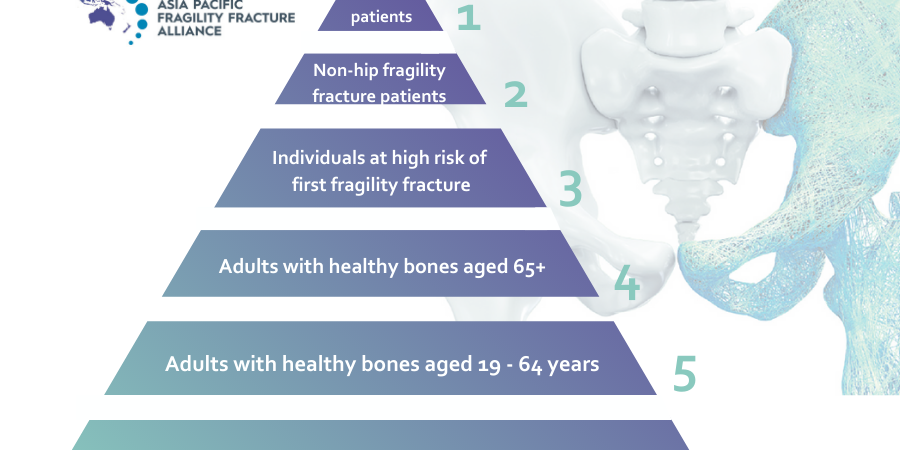Despite monumental measures aimed at prioritising osteoporosis and fracture prevention on the global health agenda, through the extensive efforts of global organisations such as the International Osteoporosis Foundation (IOF) and the Fragility Fracture Network (FFN), as well as leading regional organisations such as ours (Asia Pacific Fragility Fracture Alliance or APFFA), bone fractures represent a significant global public health and economic burden. Estimates suggest 500 million people worldwide live with osteoporosis. In 2010, it was estimated that 2.7 million hip fractures occurred worldwide and a more recent meta-analysis of over 100 studies estimated the total health and social care costs for just one hip fracture after one year to be USD 43,669.
According to Head of the School of Population Health, University of New South Wales, and Global Burden of Disease 2019 Fracture Collaborator, Professor Rebecca Ivers, Sydney, to date there has been no widescale comprehensive study of the incidence of bone fractures and their associated burden. Previous epidemiological studies of fractures have focused primarily on specific regions or countries, or particular types of fractures or anatomical sites.
“To address this distinct lack of comprehensive data, the Global Burden of Diseases Fracture Collaborators set out to analyse the global, regional, and national burden of bone fractures across 204 countries and territories between 1990–2019, published recently in The Lancet – Healthy Longevity publication.
“The study aimed to capture the global, regional, and national incidence, prevalence, and years lived with disability (YLDs) of fractures from 1990 – 2019, using the 2019 framework of the Global Burden of Diseases, Injuries, and Risk Factors Study (GBD). While the global age-standardised rates of incidence, prevalence, and YLDs for fractures decreased slightly from 1990 to 2019, by approximately 10 per cent, 6.7 per cent and 8.4 per cent respectively, the absolute counts increased substantially, largely due to population growth and a rapidly ageing global population,” said Prof Ivers.
Compared to 1990, there was a 33.4 per cent increase in the number of new fractures, totalling approximately 178 million globally. The number of new fractures was estimated to be 102 million in males compared with 76.4 million in females. However, there is a higher fracture incidence rate among women, compared with men among those aged above 64 years.
The study also cited 455 million prevalent cases of acute or long-term symptoms of a fracture, representing an increase of 70·per cent over the three decades. While a comparison of YLDs documented a 65.3 per cent increase to 25.8 years in the studied timeframe.
Fractures in the lower leg (the patella, tibia or fibula and the ankle) were the most common and burdensome fracture sites recorded in 2019, with an age-standardised incidence rate of 419.9 cases per 100,000 population, and an age-standardised rate of YLDs of 190.4 per 100,000 population. In fact, there were 15.5 million YLDs caused by fracture of these sites recorded in 2019.
This was followed by fractures at the radius or ulna, or both; and clavicle, scapula, or humerus, with an aged-standardised incidence rate of 246.1 per 100,000, and 249.2 per 100,000 respectively, in 2019.
This analysis found falls to be the leading cause of disability due to a fractured bone.
The three regions with the highest age-standardised incidence rate of fractures in 2019 were Australasia, central Europe, and eastern Europe, while the highest-ranking countries and territories were New Zealand, Slovenia, and Australia. Comparatively, the three regions with the lowest age-standardised incidence rates were Southern, Western and Central sub-Saharan Africa, and the three countries, and territories with the lowest rates were North Korea, Liberia, and Zimbabwe.
This systematic analysis demonstrates that for the 10 countries and territories with the highest age standardised rates of fracture YLDs in 2019, fracture would fall between the second and fourth leading cause of fractures (where fracture is considered to be a nature of the injury).
Regions with the highest age-standardised rates of fracture YLDs were Australasia, central Europe, and eastern Europe, with Afghanistan, New Zealand, and Slovenia representing the top three countries. The three regions with the lowest age-standardised rates of fracture YLDs were southern sub-Saharan Africa, east Asia, and western sub-Saharan Africa, and the three countries and territories were North Korea, Taiwan, and Kiribati.
According to APFFA Project Manager, Adjunct Associate Professor Paul Mitchell, New Zealand, the results of this study will assist in identifying the current burden of fractures and facilitate development of global, regional, and national responses to support the prevention and treatment of fractures. Furthermore, the comprehensive findings will allow policy makers to prioritise locations and age groups with the highest incidence and disability due to fractures.
“Importantly, the study offers policy makers and medical professionals crucial information on the most burdensome fracture sites and the types of injury that contribute most profoundly to health and economic burden levels. The widescale analysis further emphasises the important role that fracture prevention and optimised treatment can play in reducing the overall disability burden worldwide,” said Adj. A/Prof Mitchell.
Several important findings that may help to reduce the incidence and burden of fractures have been reinforced by this study, including:
- Efforts to expand screening, treatment and management of osteoporosis (e.g. adopting exercise routines and diets that promote bone strength; and providing educational materials, assistive devices, and other products to reduce the risk of falls) may help reduce the number of fractures sustained, particularly among older age groups, who account for the majority of fractures.
- Emphasis should be placed on policies designed to mitigate occupational hazards, and provide safe work environments.
- For countries with the highest-ranking age-standardised disability burden, focusing on policies aimed at preventative measures should be prioritised.
- Management of fracture sites should be stratified, so the type, timing and duration of treatment is applied in accordance with the anatomical site. For example, fractures of the radius or ulna, or both, can be treated with conservative methods, while surgical intervention for fractures of the radius or ulna have reportedly offered no clear benefit over conservative methods. Fractures at other anatomical sites, such as the patella, tibia or fibula, or ankle and clavicle, scapula, or humerus have a high risk of delayed intervention, accompanied by large economic costs, and loss of productivity, and could therefore be treated more urgently and proactively.
“APFFA welcomes the publication of such large-scale, comprehensive and informative data analyses. Given our primary mission is to drive policy change, improve awareness and change political and professional mindsets to facilitate optimal fragility fracture management across the Asia Pacific, systematic analyses of this nature can be harnessed to make major contributions to shaping policy for the Asia Pacific region,” Adj. A/Prof Mitchell said.





